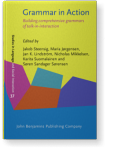Chapter 11
An interactional grammar of insubordination
The case of French si ‘if’-clauses
We take French si ‘if’-clauses as an
exemplary case to reflect on how questions about the structures of a
language can be fruitfully addressed by considering the
conversational actions that speakers accomplish by means of these
structures. We demonstrate that an interactional perspective has the
potential (a) to shed light on interactional motivations for the
formal implementation of ‘if’-clauses, (b) to deepen our
understanding of the workings of insubordination, and (c) to open a
window onto continua of (in)subordination. Scrutinizing grammatical
patterns in relation to temporality/emergence, to the grammar-body
interface, and to social action has profound implications for
understanding core features of grammar — such as clause-combining
and (in)subordination — and for how these features should be
represented in a grammar of language use.
Article outline
- 1.Introduction
- 2.Background
- 2.1A cline of (in)subordination
- 2.2Parameters for examining and describing ‘if’-clauses
as they
occur in social interaction
- 2.2.1Position of main and subordinate clause
- 2.2.2Degrees of syntactic integration, co-construction, and
incrementation
- 2.2.3Free-standing ‘if’-clauses
- 2.2.4Grammar and the body
- 2.2.5In sum: Parameters for analysis
- 3.Analysis
- 3.1Incremental composition
- 3.2Co-construction
- 3.3Free-standing si ‘if’-clauses: A continuum
of insubordination
- 3.3.1Fully insubordinate si
‘if’-clauses
- 3.3.2Pseudo-autonomous si ‘if’-clauses based
on structural latency
- 3.3.3Pragmatically dependent si ‘if’-clauses
based on contextual inferences
- 3.3.4Highly routinized formulaic si
‘if’-clauses akin to particle-like status
- 3.3.5Upshot: A cline of (in)subordination
- 3.4Embodied and other non-lexical completions
- 4.Discussion and conclusion
- 4.1A grammar entry for ‘if’-clauses
- 4.2Beyond the case of ‘if’-clauses: Grammar entries for
subordination, insubordination, clause-combining
-
Acknowledgments
-
Notes
-
References
This content is being prepared for publication; it may be subject to changes.
